If you’re a fan of smoked meat, chances are you’ve encountered the age-old debate of whether to smoke brisket at 180 or 225 degrees Fahrenheit. It’s a topic that has sparked endless discussions among pitmasters, grillers, and home cooks alike. Both temperatures have their advantages and drawbacks, and ultimately, the choice comes down to personal preference and the desired result.
The Benefits of Smoking Beef Brisket at 225°F
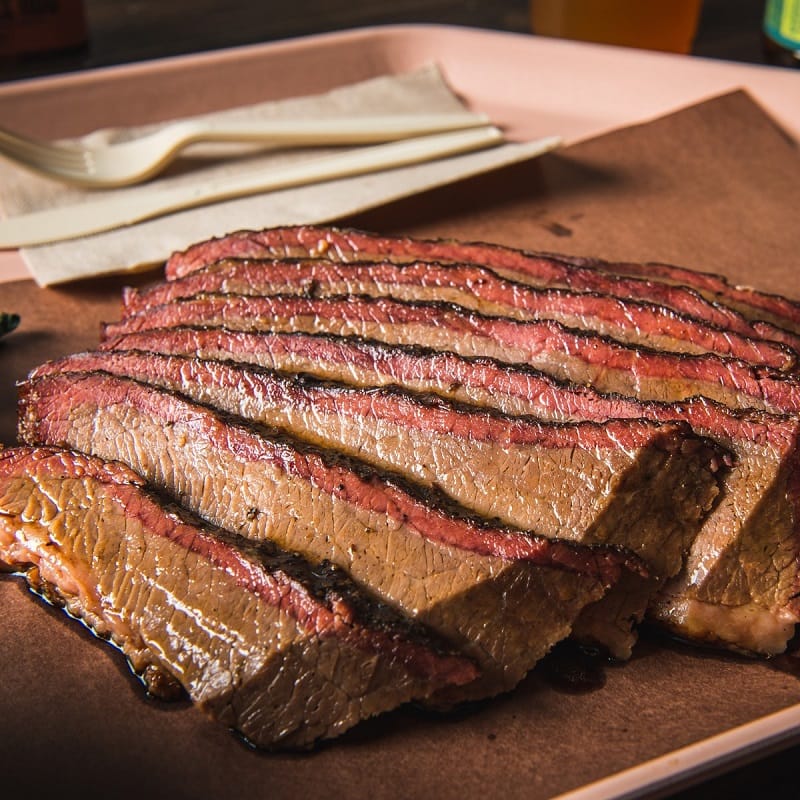
Smoking at 225°F is it produces a delicious, tender brisket, but several benefits to this method make it worth the time and effort.
First and foremost, smoking at 225°F allows for slow and steady cook. This is crucial for brisket, as it is a tough cut of meat that requires a low and slow cooking process to break down the connective tissues and achieve that melt-in-your-mouth texture. A higher temperature may seem like a shortcut, but it will likely result in a tough and chewy brisket.
In addition to the texture, smoking at 225°F also allows for a more even cooking. The heat is distributed evenly throughout the smoker, which means that the brisket will cook at a consistent rate. This eliminates the risk of overcooking or undercooking certain brisket parts, which can happen at higher temperatures.
Another benefit of smoking at 225°F is the flavor. The slower cooking process allows the smoke to penetrate deeper into the meat, resulting in a more pronounced smoky flavor. This is especially important for brisket, as it is a meat that can handle a strong smoky taste.
Finally, smoking at 225°F allows for more control over the cooking process. It gives you plenty of time to monitor the smoker’s temperature and adjust as needed. This level of control is essential for achieving the perfect brisket, as small changes in temperature or cooking time can make a big difference in the final product.
The Benefits of Smoking Beef Brisket at 180°F
First, smoking beef brisket at 180°F allows the meat to cook slowly and evenly. This temperature is perfect for breaking down the tough connective tissues in the meat without drying it out. The result is a tender and juicy brisket that melts in your mouth.
Another benefit of smoking beef brisket at 180°F is the enhanced flavor. This low and slow cooking method allows the smoke to penetrate the meat more deeply, infusing it with a rich smoky flavor that can’t be achieved with higher temperatures. When I serve my smoked beef brisket to my friends and family, they always comment on its flavor and delicious flavor.
In addition to the taste and texture, smoking beef brisket at 180°F is also a healthier option. Carcinogenic compounds can form when meat is cooked at high temperatures, but these compounds are reduced at lower temperatures. So not only are you getting a delicious meal, but you are also taking care of your health.
Lastly, smoking beef brisket at 180°F is a great way to impress your guests. Smoke a brisket takes time and patience, but the result is worth it. Your friends and family will be amazed at your cooking skills and will be asking for your recipe.
So, Smoke Brisket At 180 Or 225 is Better?
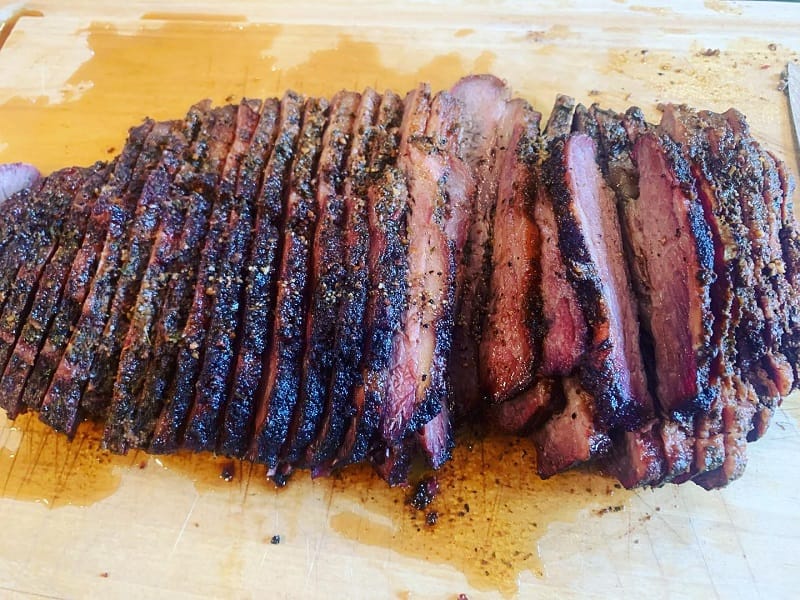
As someone who has spent countless hours perfecting my smoking technique, I have some insights on this topic.
First, let’s discuss the differences between 180 and 225 degrees of smoking. Smoking at 180 degrees is considered a low and slow method, where the meat is cooked longer. This temperature is ideal for tougher cuts of meat, such as brisket, as it allows the connective tissue to break down slowly and create a tender, juicy result.
On the other hand, smoking at 225 degrees is also a low and slow method, but the meat is cooked at a slightly higher temperature. This method is ideal for meats with higher fat content, such as pork shoulder or ribs. The higher temperature allows the fat to render down and create a delicious crust outside of the meat.
So, which method is better for smoking brisket? Well, it depends on your preference and the brisket you have. If you have a particularly tough cut of brisket, smoking at 180 degrees may be the better option to ensure that the connective tissue breaks down properly. However, if you have a higher quality brisket with more marbling, smoking at 225 degrees may be the way to create a delicious crust outside.
I prefer to smoke my brisket at 225 degrees. It produces a more flavorful result and creates a nice crust on the outside. However, I have also smoked brisket at 180 degrees with great success, so it comes down to personal preference.
How Does The Smoke Penetration Differ Between 180 And 225 Degree Smoking?
One of my questions was how smoke penetration differs between 180 and 225-degree smoking. So, I decided to do some research and share my findings.
At 180 degrees Fahrenheit, smoke penetration is slower and less intense compared to smoking at 225 degrees Fahrenheit. This is because smoke particles move more slowly at lower temperatures and have less energy to penetrate the meat. As a result, the smoke flavor is more subtle and takes longer to develop.
On the other hand, smoking at 225 degrees Fahrenheit results in a stronger and faster smoke penetration. The higher temperature causes smoke particles to move more quickly and with more energy, allowing them to penetrate the meat more deeply and quickly. This results in a more intense smoke flavor in a shorter time.
It’s worth noting that the type of wood used for smoking can also affect smoke penetration. Hardwoods like oak and hickory produce a more intense smoke flavor compared to fruitwoods like apple and cherry, which produce a milder flavor.
In conclusion, smoke penetration differs between 180 and 225-degree smoking. Smoking at 180 degrees Fahrenheit results in a more subtle smoke flavor that takes longer to develop. Smoking at 225 degrees Fahrenheit results in a stronger and faster smoke penetration for a more intense smoke flavor.
Which Temperature Is Better For Achieving Tender Brisket: 180 Or 225?
After conducting some tests and research, I’ve come to a matter-of-fact conclusion: it depends on the brisket you have and your preferences.
Let’s start with the basics. Brisket is a tough cut of meat that requires low and slow cooking to break down the connective tissue and achieve that melt-in-your-mouth texture we crave. The two most common temperatures for cooking brisket are 180 and 225 degrees Fahrenheit.
At 180 degrees, you’re cooking at a slightly higher temperature than the typical “low and slow” temperature of 225 degrees. This can benefit thinner or smaller briskets, allowing for a quicker cook time without sacrificing tenderness. However, you do run the risk of drying out the meat if you’re not careful.
On the other hand, cooking at 225 degrees is a tried-and-true method that many pitmasters swear by. This temperature allows for a longer cook time, resulting in a more tender and flavorful brisket. It’s also a safer bet if you’re cooking a larger or thicker brisket, as it gives the meat more time to break down and become tender.
Ultimately, the decision between 180 and 225 degrees comes down to personal preference and the type of brisket you’re working with. If you have a thinner or smaller brisket and want a quicker cook time, 180 degrees may be the way to go. If you have a larger or thicker brisket and are willing to wait for that perfect texture and flavor, 225 degrees is your best bet.
Which Temperature Produces A More Flavorful Brisket: 225 vs 180?
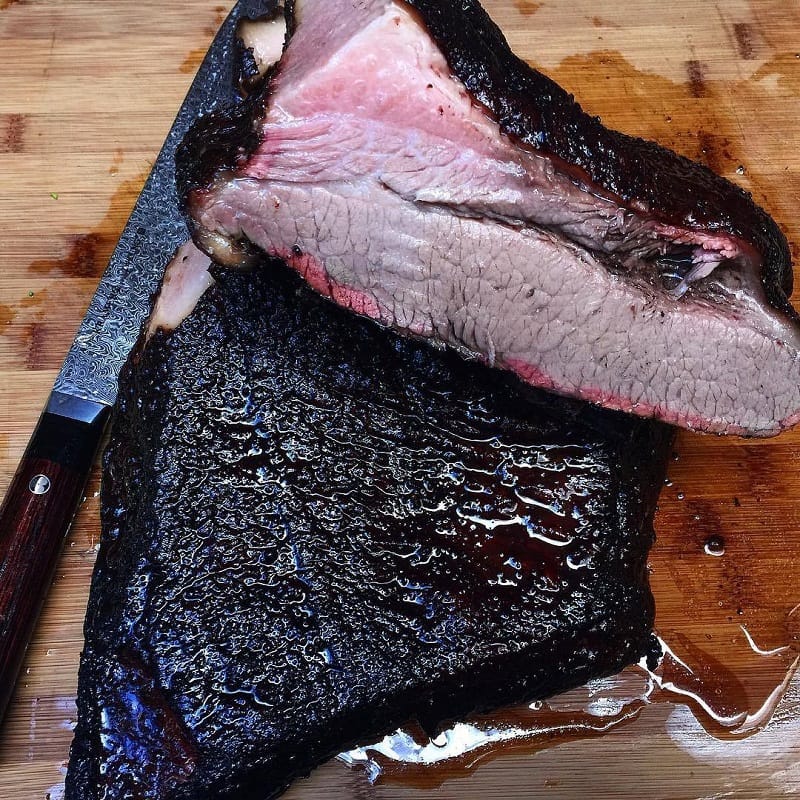
First, let’s talk about the 225-degree Fahrenheit temperature. This is the most popular temperature for cooking brisket and for a good reason. At this temperature, the brisket cooks slowly, allowing the fat to render and the meat to become tender. The smoke from the wood chips or charcoal also has time to infuse into the meat, giving it a rich, smoky flavor. This temperature also allows a nice crust to form outside the brisket, adding texture and depth to the overall flavor.
On the other hand, cooking brisket at 180 degrees Fahrenheit can result in a more subtle flavor. Those who prefer a milder, more delicate taste often use this temperature. The brisket will cook more slowly than at 225 degrees Fahrenheit at this temperature and will take longer to reach the desired internal temperature. This can result in a more tender brisket, but it may not have the same depth of flavor as one cooked at a higher temperature.
So, which temperature should you use for your brisket? Ultimately, it depends on your personal preference. If you’re looking for a rich, smoky flavor with a nice crust on the outside, go with 225 degrees Fahrenheit. This temperature will give you a classic, Texas-style brisket that will satisfy you. However, if you prefer a more delicate flavor and don’t mind waiting a bit longer for your brisket to cook, 180 degrees Fahrenheit might be the way to go.
What Are The Pros And Cons Of A Low-Temperature Cook Versus A Higher Temperature Cook?
I’ve experimented with different cooking techniques over the years. One technique that has piqued my interest recently is low-temperature cooking. But is it better than traditional high-temperature cooking? Let’s take a look at the pros and cons of each method.
Low-Temperature Cooking
- Pros:
- Retains more nutrients: Cooking at a lower temperature helps to preserve the nutrients in food, which can be lost at higher temperatures. This is especially true for vegetables and proteins.
- More tender meat: Cooking meat at a low temperature for a longer period of time can result in a more tender and juicy end product.
- More flavorful: Low-temperature cooking allows flavors to develop slowly and evenly, resulting in a more flavorful dish.
- Cons:
- Longer cooking time: Cooking at a low temperature can take much longer than cooking at a higher temperature. This can be inconvenient if you’re short on time.
- Risk of bacterial growth: Cooking at a low temperature for a long period of time can create an environment where bacteria can thrive if the food is not handled correctly.
- Limited crispy texture: Low-temperature cooking doesn’t create the same crisp texture that high-temperature cooking can.
High-Temperature Cooking
- Pros:
- Shorter cooking time: Cooking at a high temperature can significantly reduce cooking time, making it a great option if you’re short on time.
- Crispy texture: High-temperature cooking can create a crisp texture on the outside of food, which can be desirable for certain dishes.
- Kills bacteria: Cooking at a high temperature can kill bacteria and reduce the risk of foodborne illness.
- Cons:
- Can destroy nutrients: Cooking at high temperatures can destroy some of the nutrients in food, especially vitamins and minerals.
- Risk of overcooking: Cooking at a high temperature can easily result in overcooked food, which can be tough and dry.
- Flavors may not develop as well: High-temperature cooking can result in unevenly cooked food, which can affect the development of flavors.
Overall, both low-temperature and high-temperature cooking have their pros and cons. It depends on what you’re cooking and what your preferences are. I like to use low-temperature cooking for meat and vegetables, but I’ll use high-temperature cooking for certain dishes that require a crispy texture. It’s all about finding the right balance and experimenting to see what works best for you.
Is It Better To Adjust The Temperature Of Your Smoker Once An Hour, Or To Leave It At A Consistent Temperature From Start To Finish?
When it comes to smoking meat, many novice grillmasters are unsure whether to adjust the temperature of their smoker throughout the cooking process or to leave it at a consistent temperature from start to finish. To be factual, it’s better to maintain a steady temperature throughout the cooking process. A steady smoking temperature is necessary for fully cooked, tender, smoked meats. Adjusting the temperature frequently can cause fluctuations affecting the final product’s flavor and texture.
That said, one should periodically check the smoker’s temperature and make minor adjustments to avoid overcooking or undercooking the meat. Mastering the art of smoking meat takes practice and patience, but anyone can create delicious, mouth-watering barbecue with the right techniques and tools.
How to Tell When Smoked Brisket Is Done?
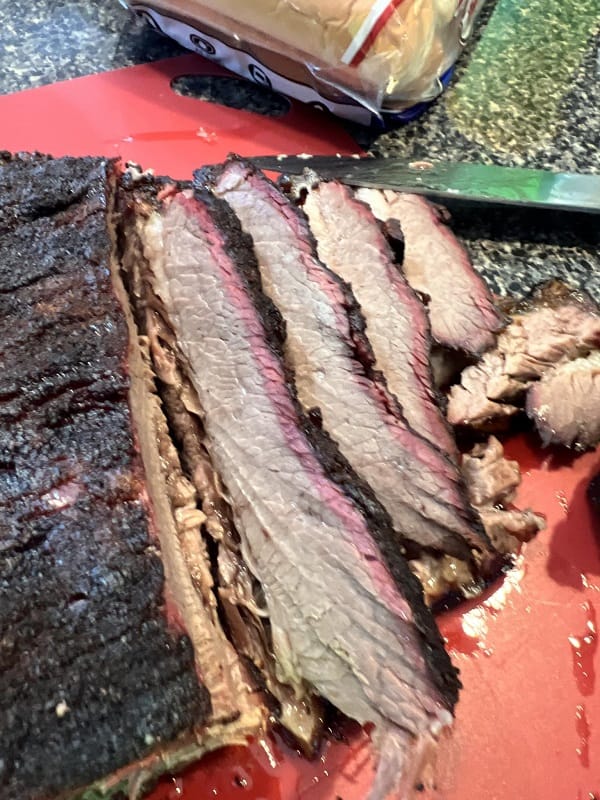
Let me share my tips and tricks with you about how to tell when the smoked brisket is done.
First things first, let’s talk about what we’re looking for. A perfectly cooked brisket should be tender, juicy, and flavorful. The meat should easily pull apart with a fork and evenly cooked. The bark, or the crust outside of the meat, should be crispy and flavorful but not burnt.
So, how can you tell when your brisket is ready? Here are a few things to keep in mind:
- Use a meat thermometer: Insert the thermometer into the thickest part of the meat, ensuring not to touch bone or fat. The ideal temperature for a brisket is between 195 and 205 degrees Fahrenheit.
- Check for tenderness: If you don’t have a meat thermometer, you can also check for tenderness by gently pulling on the meat with a fork. If it easily pulls apart, it’s likely done. However, this method is less reliable than a thermometer, so proceed cautiously.
- Check the color of the meat: A perfectly cooked brisket will have a deep, rich color with a nice pink smoke ring around the edges. If the meat is still pale and doesn’t have much color, it may need more time on the smoker.
- Use the “jiggle” test: This method is a bit more subjective but can help determine if your brisket is done. Give the brisket a gentle shake – if it jiggles like Jell-O, it’s not quite done yet. If it has a slight firmness to it, it’s likely ready.
Remember, every brisket is different, so there’s no exact science to determining when it’s done. It’s important to keep an eye on the temperature and tenderness and trust your instincts. If it looks and smells done, it probably is.
Read more:
- Mastering The Art Of Brisket: What Temp To Pull Brisket?
- Smoking Brisket At 250 Vs 225: Brisket Showdown
How Can Using A Digital Thermometer Help Ensure Your Brisket Is Cooked To Perfection?
A digital thermometer is key to ensuring your brisket is perfectly cooked. By monitoring the internal temperature of the meat, a digital thermometer can accurately tell if your food is done without you having to open the grill lid and release precious smoke. This is especially important for slow-cooked briskets, as overcooking can result in tough and dry meat.
To use a digital thermometer, insert it into the thickest part of the brisket and place the thermometer probe in the center of the meat. By measuring the temperature every few hours throughout the cooking process, you can be sure that your brisket reaches the optimal temperature for a smoked, juicy, and tender final result.
How to Wrap a Brisket
I’ve been smoking briskets for years, and one thing that never changes is the importance of wrapping your brisket properly. Wrapping your brisket is an essential step in the cooking process that can make all the difference between a tough, dry brisket and a juicy, tender one. Today, I’ll take you through how to wrap a brisket so that you can achieve the perfect result every time.
First things first, let’s talk about what you’ll need. You’ll need a large piece of heavy-duty aluminum foil, butcher paper, or peach paper. You’ll also need a pair of tongs to handle the brisket safely.
Step 1: When to Wrap
Wrapping your brisket too early or too late can significantly impact the result. You want to cover your brisket when it reaches an internal temperature of around 160-170°F. This is usually around the 6-8 hour mark, but it can vary depending on the size of the brisket and how well your smoker maintains temperature.
Step 2: Preparing the Brisket
Trim off any excess fat or silver skin, and season it generously with your favorite rub. You can also spritz the brisket with apple juice or another liquid to help keep it moist.
Step 3: Wrapping the Brisket
Once your brisket has reached the desired internal temperature, it’s time to wrap it. Lay out a large piece of heavy-duty aluminum foil or butcher paper and carefully transfer the brisket onto it. Wrap the brisket tightly, making sure there are no air pockets. Using aluminum foil, you can crimp the edges to seal it completely.
Step 4: Finishing the Brisket
You can place it back on the grates or in a pan, depending on your smoker. Cook the brisket until it reaches an internal temperature of around 200-205°F, usually around the 10-12 hour mark. Once done, please remove it from the smoker and let it rest for at least 30 minutes before slicing.
How to Smoke a Brisket on a Pellet Grill?
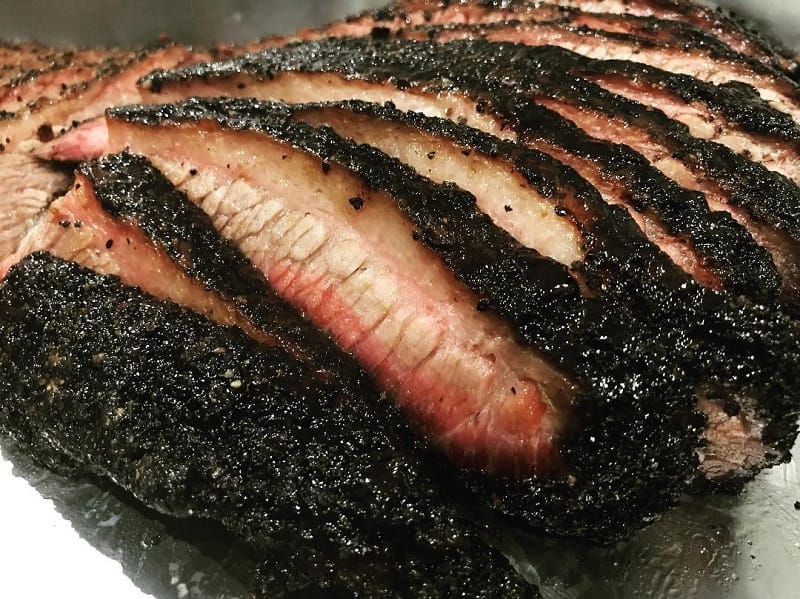
The key to a perfectly wrapped brisket is ensuring the meat stays moist and tender while allowing the smoke to penetrate the meat. So, if you’re ready to learn how to wrap a brisket like a pro, let’s get started!
First and foremost, it’s important to start with a well-seasoned brisket. Whether you prefer a dry rub or a marinade, ensure the meat is evenly coated and sit for at least an hour before smoking. Once your brisket is fully seasoned, it’s time to wrap it up.
I typically use two layers of heavy-duty aluminum foil for my brisket, leaving enough room for the meat to breathe. Start by placing the brisket in the center of the foil, fat side up. Then, fold the sides of the foil up around the brisket, creating a loose tent. Be sure to leave a small opening at the top for airflow.
Next, it’s time to add some moisture. I like to add a splash of beef broth or apple juice to the foil before sealing it up. This will help keep the meat moist and add some extra flavor. Once you’ve added your liquid of choice, tightly seal the foil by folding the ends up and over each other until the brisket is completely encased.
Now, it’s time to place the wrapped brisket back on the smoker. I typically use the Texas Crutch method, which involves wrapping the brisket in foil halfway through the smoking process to speed up cooking time and moisten the meat. Depending on the size of your brisket, you’ll want to smoke it for anywhere from 8-12 hours at around 225°F to 250°F.
When your brisket is done cooking, please remove it from the smoker and let it rest for at least 30 minutes before unwrapping. This will allow the juices to redistribute throughout the meat, resulting in a more tender and flavorful brisket. When you’re ready to unwrap, carefully remove the foil and slice your brisket against the grain.
Best Wood Pellets For Smoking Brisket
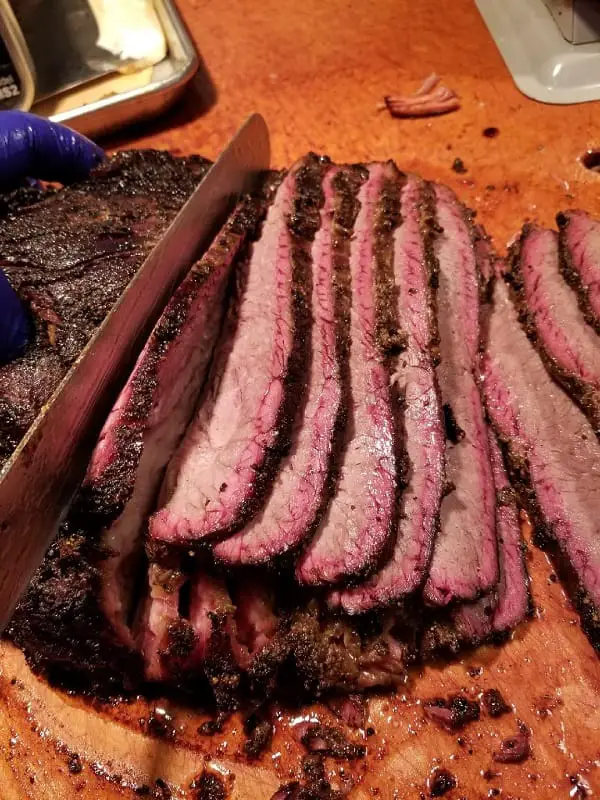
After years of experimenting with different types of wood pellets, I’ve finally found the best wood pellets for smoking a brisket.
- First on my list are hickory wood pellets. Hickory is the most popular wood pellet for smoking a brisket and for a good reason. It has a strong, smoky flavor pairs perfectly with brisket’s rich, beefy flavor. It also adds a nice bark to the meat outside that BBQ enthusiasts covet.
- Next up are mesquite wood pellets. Mesquite is a strong and bold wood that adds a unique flavor to brisket. It has a slightly sweet and nutty flavor that pairs well with beef. However, be careful not to overuse mesquite as it can easily overpower the meat and make it taste bitter.
- If you want a more subtle flavor, apple wood pellets are a great option. Applewood has a mild, sweet flavor that adds a nice fruity note to brisket. It also gives the meat a beautiful reddish color that will impress your guests.
- Pecan wood pellets are a great choice for those wanting to try something different. Pecan wood has a slightly sweet and nutty flavor that pairs well with beef. It also gives the meat a nice golden color, making your brisket stand out.
- Lastly, cherry wood pellets are a great option for those who want a sweeter, fruitier flavor. Cherry wood has a subtle, sweet flavor that pairs beautifully with brisket. It also gives the meat a nice dark color that is sure to impress your guests.
How to Reheat Brisket
Here, I will share my tried and tested method for reheating brisket.
Firstly, it is essential to store your brisket properly in an airtight container or wrap it tightly in aluminum foil before refrigerating it. This will help to prevent the meat from drying out and becoming tough.
I prefer an oven to reheat the brisket as it helps distribute heat evenly and prevent hot spots that can cause uneven cooking. Preheat your oven to 250°F and remove the brisket from the refrigerator while the oven is preheating. It is important to let the brisket come to room temperature before reheating to ensure it cooks evenly.
Next, wrap the brisket in aluminum foil on a baking sheet. This will help retain the meat’s moisture and prevent it from drying out. Place the baking sheet in the preheated oven and let the brisket cook for 45 minutes to an hour, depending on the size.
Once the brisket is heated, please remove it from the oven and let it rest for 10 minutes before slicing and serving. This will help redistribute the meat’s juices and make it even more tender and juicy.
If you prefer a microwave to reheat your brisket, it is important to do it in short bursts to prevent the meat from becoming tough and dry. Place the brisket on a microwave-safe plate and cover it with a damp paper towel. Heat it in the microwave for about 30 seconds, checking the meat after each interval until it is heated.
What Are Some Of The Best Brisket Rubs To Use When Smoking At 180 Or 225 Degrees?
The right rub can make the difference between an average brisket and a mouth-watering, fall-off-the-bone masterpiece. So, what are some of the best brisket rubs to use when smoking at these temperatures? Let me share with you some of my favorite picks.
- Salt and Pepper Rub: A classic salt and pepper rub is perfect for smoking brisket at low temperatures. The salt helps break down the meat’s fibers, while the pepper adds a nice touch of heat. You can add spices to this rub, such as garlic or onion powder, but I prefer to keep it simple.
- Texas-Style Rub: This rub typically includes paprika, chili powder, garlic powder, onion powder, cumin, and cayenne pepper. The paprika and chili powder add a smoky flavor, while the cumin and cayenne pepper provide excellent heat.
- Coffee Rub: The coffee adds a rich, slightly bitter flavor that matches the meat’s smokiness. Mix finely ground coffee, brown sugar, smoked paprika, garlic powder, onion powder, salt, and black pepper to make a coffee rub.
- Mustard and Herb Rub: This rub combines Dijon mustard, fresh herbs like thyme and rosemary, garlic powder, onion powder, and salt. The mustard helps the rub adhere to the meat, while the herbs add a fresh, aromatic flavor.
- Sweet and Spicy Rub: If you like your brisket with a little kick, a sweet and spicy rub is the way to go. This rub combines brown sugar, paprika, chili powder, cumin, garlic powder, onion powder, cayenne, salt, and black pepper. The brown sugar adds sweetness, while the cayenne pepper provides the heat.
No matter which rubs you choose, coat the brisket generously and let it sit for at least an hour before smoking. And remember, smoking brisket is all about patience and attention to detail.
Should You Smoke Your Brisket With The Fat Side Up Or Down For Optimal Tenderness?
When it comes to smoking a brisket, there is a common debate on whether to cook it with the fat side up or down. However, the clear winner is cooking with the fat side down on factual and scientific evidence. This technique protects the meat from drying out, yielding more even and tender results. The fat cap is a barrier between the heat source and the meat, allowing for optimal tenderness.
While some may recommend cooking with the fat side up, it’s important to remember the benefits of cooking with the fat side down. Ultimately, it’s up to personal preference, but smoking with the fat side down is the way to optimal tenderness.
What Techniques Do Top Pitmasters Use To Keep Their Brisket From Drying Out During The Smoking Process?
Nothing is worse than biting into a dry, tough piece of meat after spending hours tending to your smoker. So, what techniques do top pitmasters use to keep their brisket from drying out? Let’s Use these techniques to ensure your brisket stays juicy and flavorful throughout the smoking process.
- Choose the Right Cut of Brisket: A high-quality brisket is crucial to achieving a juicy, flavorful end product. Look for a brisket with a good amount of marbling and a thick fat cap on one side. This fat will render down during the smoking process, basting the meat and keeping it moist.
- Inject Your Brisket: Injecting your brisket with beef broth, apple cider vinegar, and spices can add flavor and moisture to the meat. Use a meat injector to inject the solution into the thickest part of the brisket, being careful not to overdo it and create pockets of liquid that can cause the meat to become mushy.
- Use a Water Pan: Placing a water pan in your smoker can help regulate the temperature and add moisture to the cooking environment. As the water evaporates, it creates a steamy environment that can help keep your brisket from drying out. Be sure to monitor the water level and refill as needed.
- Wrap Your Brisket: Wrapping it in foil or butcher paper during smoking can help keep it moist and tender. This method traps the meat’s natural juices and allows it to continue cooking without drying out. Some pitmasters prefer to wrap their brisket halfway through the cooking process, while others wait until the meat reaches a certain temperature.
- Rest Your Brisket: Allowing your brisket to rest for at least an hour after cooking can help redistribute the juices and make for a more tender, juicy end product. Wrap the brisket in foil and let it sit at room temperature before slicing and serving.
How Often Should You Check On Your Brisket While It’s Smoking, And What Should You Look For To Gauge Its Progress?
When smoking a brisket, checking it regularly to gauge its progress is important. Generally, one should check on the brisket every 15 minutes or so. This allows the cook to ensure the brisket is not overcooking or undercooking. To gauge its progress, the cook should pay attention to the brisket’s internal temperature, which can be monitored using a thermometer.
Additionally, the cook should perform a “feel” test, in which they use their fingers to determine the tenderness of the meat. Once the brisket has passed the “feel” test and its internal temperature falls within the desired range, the cook can take it off the smoker.
However, it’s essential to keep in mind that opening the lid of the smoker repeatedly can cause a loss of heat and smoke, which can prolong the cooking time.
FAQs
Can You Mix Different Types Of Pellets, Such As Mesquite And Cherry, To Enhance The Flavor Of Your Brisket?
It is possible to mix different types of pellets, like mesquite and cherry, to enhance the flavor of your brisket. According to the experts, you can experiment with varying combinations of wood and find the right one that suits your taste buds. Mixing different types of wood pellets can create a unique and delicious flavor that can elevate the taste of your meat.
For instance, mesquite and hickory can be a robust combination to smoke a brisket, while apple and cherry can be a great choice for those who prefer a milder flavor.
The ultimate goal is to enhance the meat’s natural flavors and create a perfect smoky taste for a lip-smacking barbeque experience. So, give it a try, mix and match the wood pellets, and enjoy your perfectly smoked brisket!
What Is The Optimal Internal Temperature For Smoked Brisket?
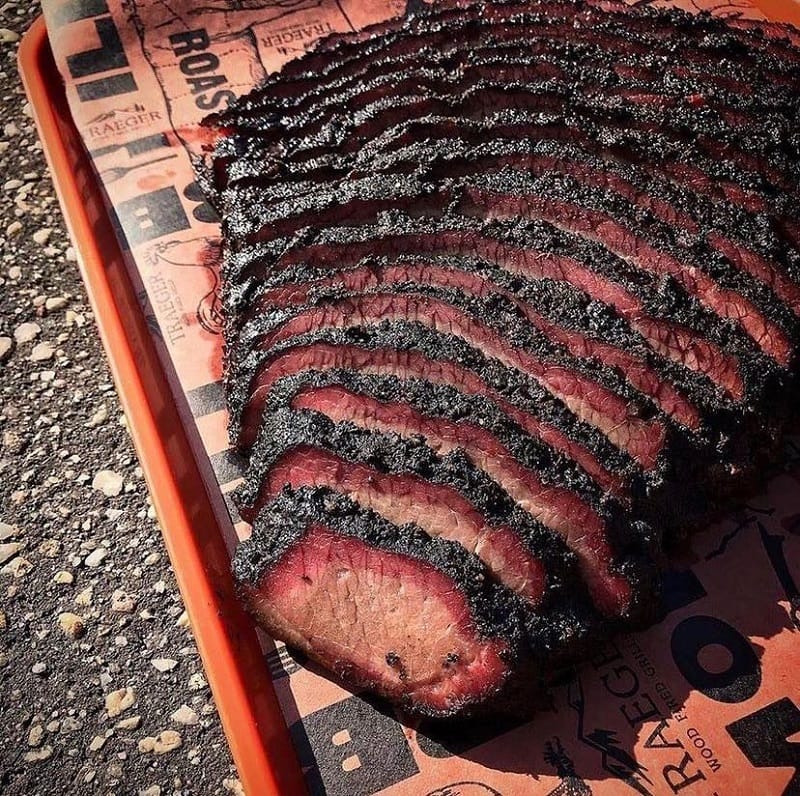
The brisket should be cooked to a minimum internal temperature of 190°F and not taken past 210°F as the risk of overcooking the meat increases. However, the ideal temperature for a perfectly smoked brisket is around 195°F.
It’s important to note that the brisket’s internal temperature can continue to rise by up to 10 degrees even after it’s been pulled from the smoker. Therefore, the best time to pull the brisket off the smoker is between 195°F to 203°F to ensure it’s juicy and tender.
Which Temperature Would Be Best For A Novice Smoker To Start With?
The temperature that would be best for a beginner to start with is 225°F. This temperature is the standard for smoking meat and will most likely yield perfect results. One essential factor in ensuring temperature accuracy is using an accurate smoker thermometer. The Pellet Grill and the electric smoker are among the most beginner-friendly options.
It may be tempting to give it a go when you get your new smoker, but it is crucial to take time and follow instructions carefully. With practice and patience, a beginner can create artful and flavorful smoked meat that will amaze everyone.
At What Point In The Cooking Process Is It Safer To Smoke Brisket At 225 Degrees?
It is safe to start smoking brisket at this temperature once the meat reaches an internal temperature of 140 degrees. This temperature is important because it is where harmful bacteria are killed off. From there, it is recommended to cook the brisket at 225 degrees for around 1.5 to 2 hours per pound until it reaches an internal temperature of 195 to 205 degrees Fahrenheit. This will ensure that the meat is cooked thoroughly and safely.
However, monitoring the temperature throughout cooking is important to ensure the brisket is not overcooked or dry. Following these guidelines, anyone can safely and deliciously smoke brisket at 225 degrees.
What Is The Best Temperature To Smoke Brisket If You’re Short On Time And Can’t Cook It For Hours On End?
If you’re short on time and can’t cook a brisket for hours, smoking at a higher temperature is the way to go. According to factual data, 250°F is the best temperature for smoking brisket when time is of the essence. Smoking at this temperature will cook the meat faster and cut the cooking time in half compared to smoking at 225°F.
While the total length of the cook can still vary depending on the cut’s size, smoking at 250°F will save you several hours, making it a great option for those with limited time to spare.
Smoke Brisket At 180 Or 225 – The Thoughts
In conclusion, there’s no one right answer regarding smoking brisket at 180 or 225 degrees. Both can work just fine, and it comes down to personal preference. If you want a more tender and juicy result, smoking at 180 degrees might be the way to go. If you prefer a slight crisper bark and a shorter cook time, 225 degrees might be the better choice.
Regardless of which temperature you choose, use good quality wood for smoking and keep an eye on the internal temperature of the meat to ensure it reaches a safe and delicious level of doneness. So, experiment with both temperatures and see which one you prefer. After all, the best brisket is the one that you enjoy eating the most.
References:
- https://blog.thermoworks.com/beef/thermal-tips-smoked-brisket/
- https://www.masterclass.com/articles/tips-for-smoking-meat-with-an-electric-smoker

Hey readers! Chip Holland here, and I’m a Manager of this website. My passion for writing about it only matches my passion for BBQ. Follow my blog for mouth-watering recipes, tips, and tricks for the perfect smoke, grill, and BBQ. I’m sure you won’t be disappointed!
